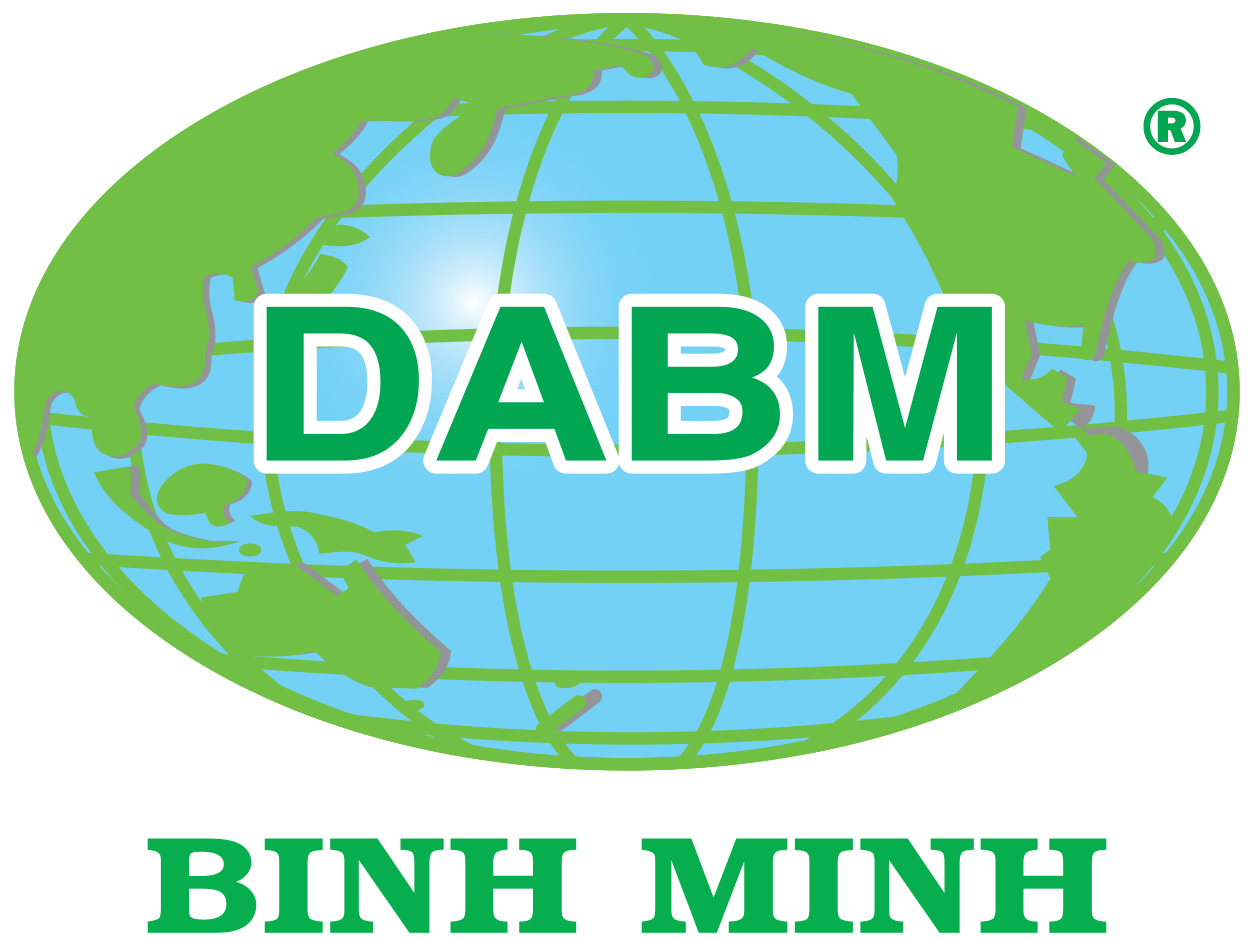Study demonstrates a strong positive relationship between total suspended solids and turbidity in all biofloc media evaluated
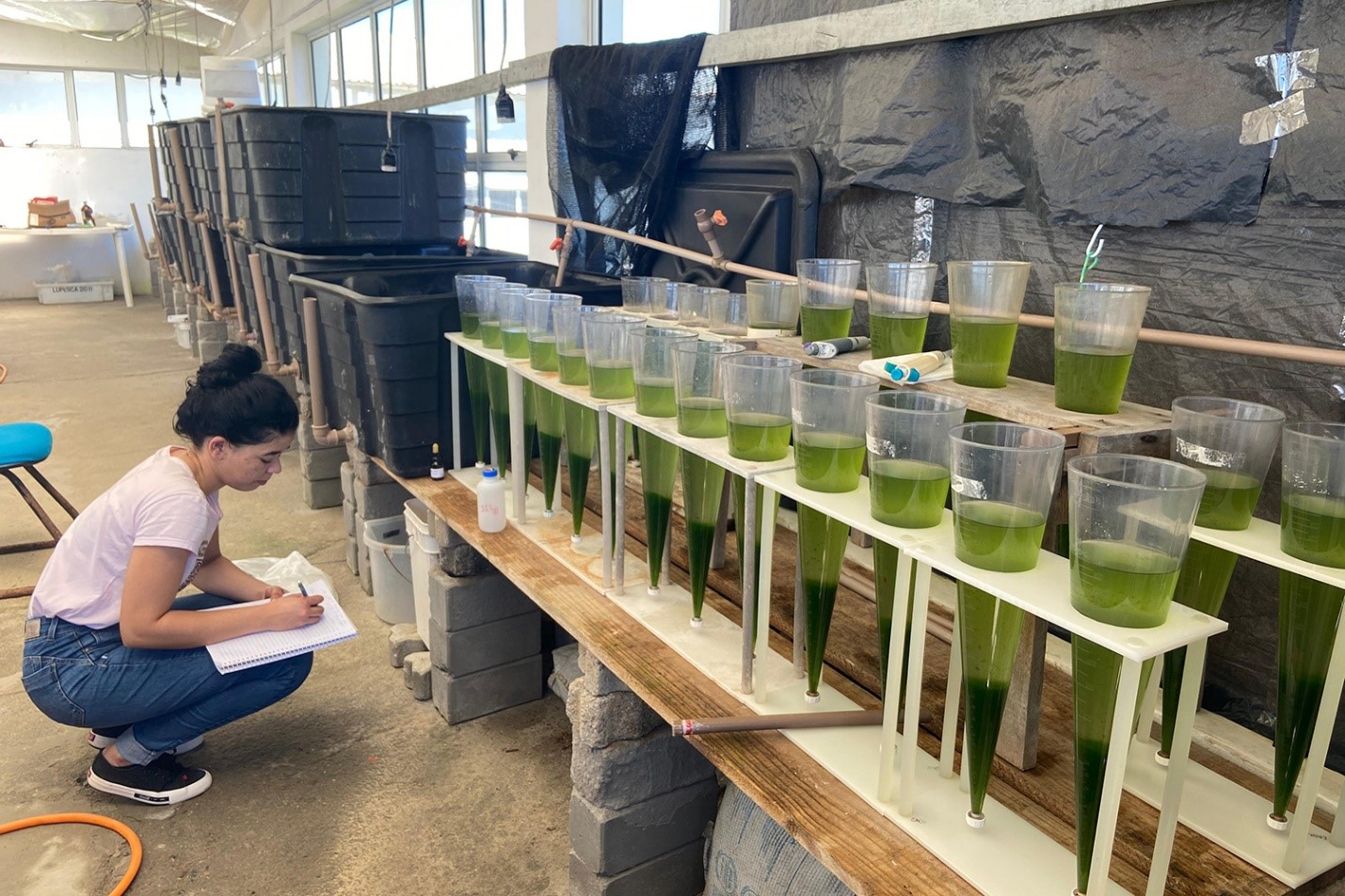
Study evaluated the estimation of total suspended solids (TSS) by floc volume and turbidity in different biofloc systems, including photoautotrophic, heterotrophic and chemoautotrophic predominance systems. Results demonstrated a strong positive relationship between total suspended solids and turbidity in all biofloc treatments evaluated and recommend estimating TSS values based on turbidity, because this is a quick, easy and practical unit of measurement to analyze throughout the production cycle.
Biofloc technology (BFT) has been applied in aquaculture to develop more sustainable cultures with minimum or no water exchange and increasing stocking densities based on the manipulation of the carbon-to-nitrogen ratio in the water. Bioflocs are formed by aggregations of unconsumed feed particles and several types of microorganisms present in the water, such as bacterial communities, protozoa, microalgae and fungi, among others. The application of this technology can promote the reuse of nitrogen compounds to form protein-rich microbial aggregates that, with constant aeration and adequate levels of dissolved oxygen, can be consumed by cultured organisms like shrimp and fish.
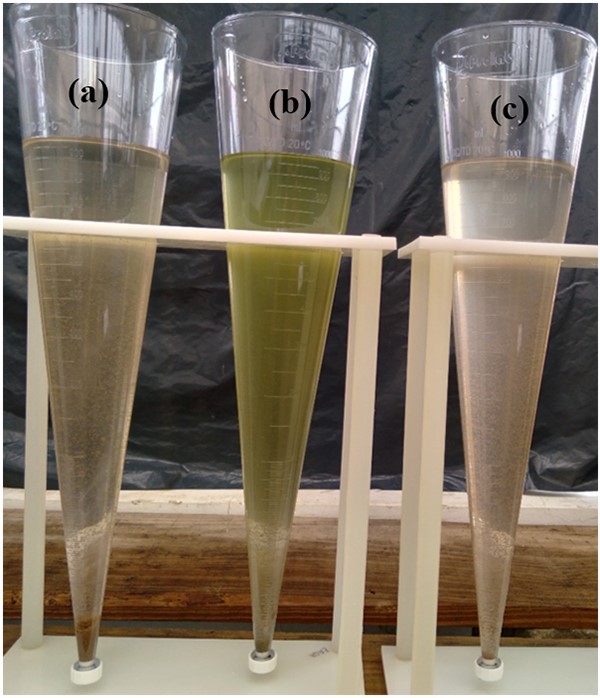
Fig. 1: Different types of bioflocs with heterotrophic (a), photoautotrophic (b), and chemoautotrophic (c) predominance applied to a culture of shrimp Penaeus vannamei.
The intensification of production associated with the constant growth of microbial biomass and the absence of water exchange can generate an increase in organic matter in the form of suspended solids, which compose the bioflocs in the culture tanks throughout the production cycle as total suspended solids (TSS) and settleable solids (SS). The constant increase in bioflocs throughout the culture can cause serious problems, such as a surge in the respiration rate that causes a drop in dissolved oxygen levels, infections by pathogenic bacteria, occlusion of gills, deposition of organic matter on the bottom with the formation of anoxic zones and reduced survival rates. Therefore, solids must be monitored and managed to ensure the proper functioning of the BFT production system.
In BFT systems there are three pathways (Fig. 1) for recycling nitrogen: photoautotrophic (use sunlight energy to produce organic materials), heterotrophic (use various sources of organic carbon), and chemoautotrophic (use chemical reactions to derive biological energy). Most systems in commercial use are intensive biofloc systems in ponds exposed to intense natural light, thus characterizing them as predominantly photoautotrophic systems. However, some systems, generally super-intensive, installed in enclosed spaces with little exposure to natural light or covered with shade cloth, are dominated by brown-colored water, predominantly heterotrophic and/or chemoautotrophic. In these culture systems, the predominantly bacterial processes maintain the water quality.
Among these three types of bioflocs, systems dominated by microalgae are characterized by higher difficulty in sedimentation and compacting solids in the Imhoff cone, compared to systems dominated by bacteria (Fig. 2). Some environmental factors can influence the sedimentation process in a predominantly photoautotrophic system such as performing an Imhoff cone analysis exposed to intense solar radiation, as well as the composition of the microalgae.
Measurement of solids
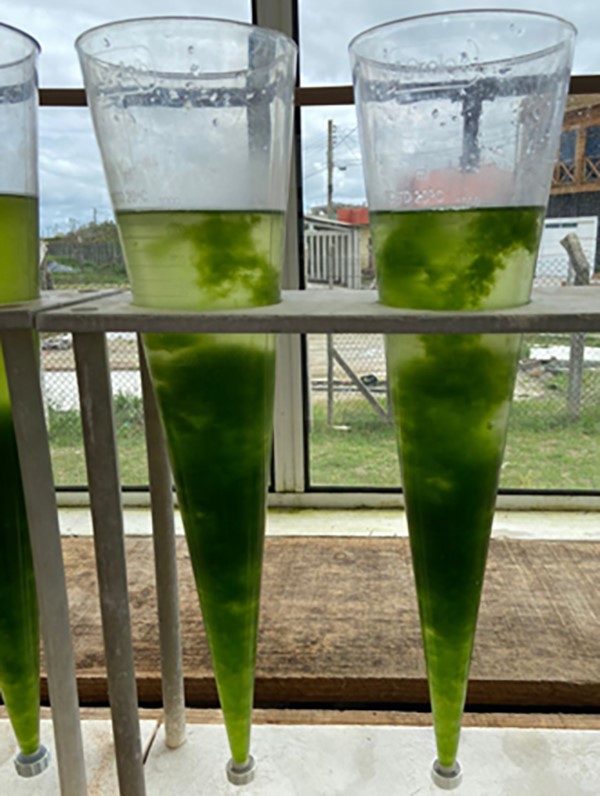
Fig. 2: Floc volume analysis in a predominantly photoautotrophic system. Note that the system dominated by microalgae does not properly sediment in the Imhoff cone.
There are several ways to measure the amount of solids present in a biofloc system using different methodologies with different analytical principles. These include (1) using an Imhoff cone to determine the SS or floc volume (FV), which is a quick and easy parameter to be evaluated through the sedimentation of bioflocs for 10 to 30 minutes; (2) the gravimetric method using fiberglass filters for TSS analysis, filtering a sample and subsequently drying this filter in an oven; and (3) turbidity analysis, which indicates the presence of suspended particles in the water through transparency and using a turbidimeter.
Maximum solids concentrations in shrimp Penaeus vannamei farming should be up to 600 mg per liter of TSS. The solids concentrations can be controlled by exchanging the water or using sedimentation tanks to remove excess particles and thus maintain water quality.
The TSS measurement method is more expensive due to the cost of filters and equipment. In addition, the time required to precisely perform the analysis is relatively long. Due to the higher cost of analyzing TSS using the gravimetric method, estimating the amount of TSS in the culture tanks as a function of turbidity or FV values is recommended, using mathematical formulas. Nevertheless, in some situations, different analytical methodologies such as TSS and FV may not present a strong relationship since as TSS concentrations increase, FV may fluctuate in the Imhoff cone. This occurs due to the composition of the microorganisms that form bioflocs and other factors, including temperature and aeration system. Therefore, estimating TSS as a function of FV for decision-making to carry out solids control must be studied, interpreted and considered carefully to be more precise. In contrast, the correlation between TSS and turbidity is considered strong.
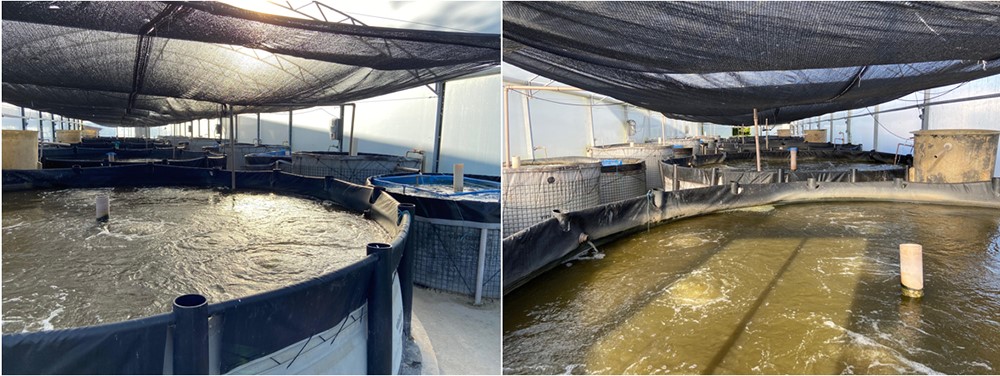
View of the experimental tanks.
In order to estimate TSS concentrations as a function of FV and turbidity in different types of bioflocs and to search for alternatives to optimize the methodologies of these analysis, this study aimed to perform correlation and regression analysis to determine the best fit (> R2) between TSS values with FV and turbidity in bioflocs with photoautotrophic, heterotrophic and chemoautotrophic predominance, in different TSS ranges.
The authors would like to thank the Coordination for the Improvement of Higher Education Personnel (CAPES), the National Council for Scientific and Technological Development (CNPq, 307741/2022-2), and the Research Support Foundation of Rio Grande do Sul (FAPERGS, project 150403/2024-0) for financial support.
Study setup
We conducted a 70-day study with Pacific white shrimp (Penaeus vannamei) in a biofloc system using 140-liter rectangular tanks located in a greenhouse at the Marine Aquaculture Station (EMA), Institute of Oceanography of the Federal University of Rio Grande (RS) in Brazil. The experiment comprised three treatments with four replicates each, which were: 1) Photoautotrophic predominance; 2) Heterotrophic predominance; and 3) Chemoautotrophic predominance. The heterotrophic and chemoautotrophic tanks were covered with 80 percent shade cloth for sunlight attenuation, while the photoautotrophic tanks were exposed to solar radiation during the day for microalgae development. Each tank had an aeration system with micro-perforated hoses (Aero-Tube®) attached to an air blower through PVC pipes. P. vannamei juveniles with an individual mean weight of 1.17 ± 0.55 grams were stocked at a density of 500 shrimp/cubic meter.
The initial concentration of TSS inoculated at the beginning of the experiment was approximately 100 mg per liter. TSS increased throughout the experimental period, until reaching the maximum established concentration of 600 mg per liter. The ranges established for performing TSS analysis to correlate them with FV and turbidity were 50–100, 300–350, and 550–600 mg per liter, which corresponded to the beginning, middle and end of this study. The sedimentation time of the Imhoff cone analysis to determine the FV was from 10 to 20 minutes for the treatment with heterotrophic and chemoautotrophic predominance, and from 10 to 30 minutes for the treatment with photoautotrophic predominance.
Results and discussion
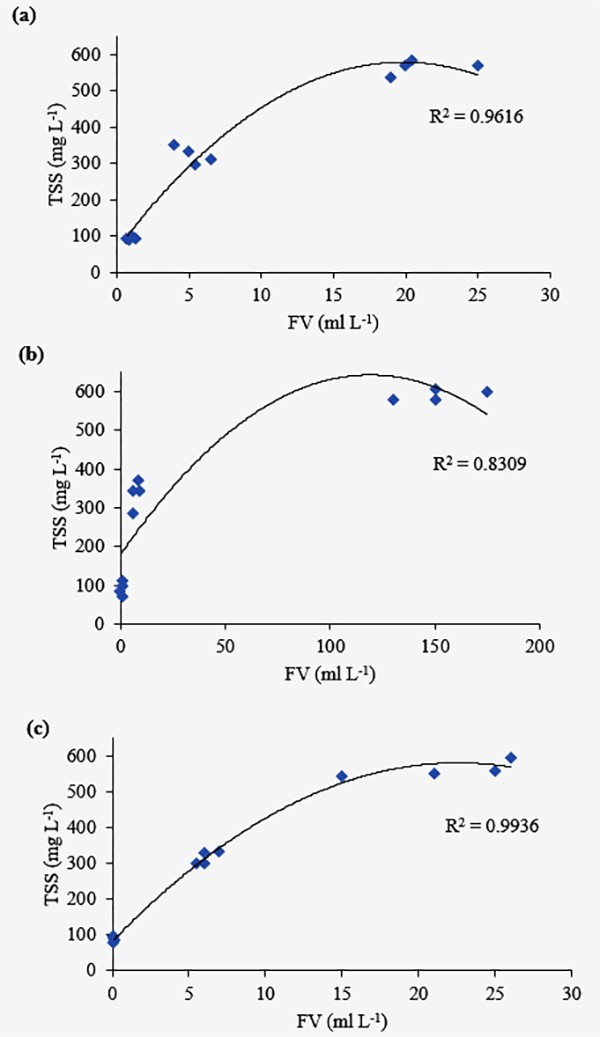
Fig. 3: Relationship between total suspended solids (TSS) and floc volume (FV) in a study with Penaeus vannamei cultured for 70 days in bioflocs of photoautotrophic (a), heterotrophic (b), and chemoautotrophic (c) predominance, with a fitted line by quadratic polynomial regression. R2 is the coefficient of determination.
The correlation coefficient (R) determines the direction and strength of the relationship between two variables and its value always ranges from -1 to +1. A value of R near or equal to ± 0.3 indicates a weak correlation, a value of R near or equal to ± 0.5 indicates a moderate correlation, and a value of R equal to or higher than 0.7 indicates a strong correlation. Squaring the correlation coefficient results in the value of the coefficient of determination (R2), which is a measure used to evaluate the precision of a relationship between two variables in addition to explaining the proportion of the variance in the dependent variable that is estimated or explained by the independent variable using regression analysis to determine the best fit (> R2).
In this research, the results demonstrated that the correlation between TSS and turbidity presented values of R2 = 0.9792 (photoautotrophic predominance), R2 = 0.9799 (heterotrophic predominance), and R2 = 0.9847 (chemoautotrophic predominance), with a strong positive relationship in all treatments. The correlation analysis between TSS and FV revealed R2 values ranging from 0.8309 to 0.9936 in all treatments (Fig. 3), which also had a strong positive relationship. Despite this, in the treatment with heterotrophic predominance (Fig. 3b) the relationship between TSS and FV showed the lowest R2 value, compared with the other treatments. This may be attributed to the fluctuation of the floc volume, FV, in the Imhoff cone.
In the system with heterotrophic predominance, we observed that from 350 mg per liter of TSS the solids had a rapid increase rate, becoming gelatinous and with larger particles in their sedimentation in the Imhoff cone. The correlation analysis between TSS and FV in the system with heterotrophic predominance may have been negatively affected by some factors such as the presence of filamentous bacteria that appear during the production cycle. The factors that contribute to the emergence of filamentous microorganisms may be related to stress conditions, low dissolved oxygen levels, low feed availability, and nitrogen deficiency, causing the formation of large aggregates with irregularly shaped. This excessive growth of these filamentous microorganisms difficults the sedimentation of solids in an Imhoff cone.
In the photoautotrophic predominance system, when the FV analyses are performed in the presence of solar radiation, the sedimentation and compaction of bioflocs in an Imhoff cone are prevented. In this research, the strong positive relationship observed between TSS and FV in the system with photoautotrophic predominance was possible because the experimental units were installed in a greenhouse and the place where the Imhoff cone analyses were performed was shaded with a black plastic sheeting tarp to prevent the influence of the light intensity, which helped with biofloc sedimentation.
TSS was strongly correlated with turbidity because as TSS concentrations increased, turbidity values also increased, which resulted in a strong relationship. The negative influence of filamentous microorganisms on turbidity analysis was not observed.
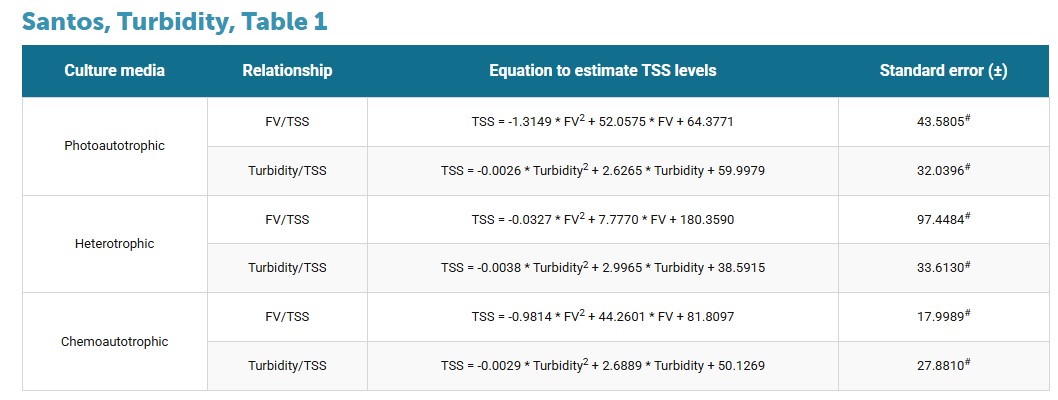
Table 1: Equation of the quadratic polynomial regression line to estimate total suspended solids (TSS) as a function of floc volume (FV) and turbidity in a study with Penaeus vannamei cultured for 70 days in bioflocs of photoautotrophic, heterotrophic, and chemoautotrophic predominance. #Standard error of the TSS value, which represents the confidence interval determined by the coefficient of determination (R2).
Perspectives
Based on the results of this study we recommend estimating TSS values as a function of turbidity, because this is a quick, easy, and practical unit of measurement to analyze throughout the shrimp production cycle. To determine the FV of a predominantly photoautotrophic system, we suggest conducting the Imhoff cone analysis in a place without the presence of solar radiation. However, new studies are being developed using chemical products that are used in the treatment of water quality and effluents. We are assessing these products at the EMA to force the sedimentation of the solids of biofloc systems in the Imhoff cones, regardless of their composition, for a stronger relationship of TSS and FV in different types of bioflocs and for an easy, quick and effective methodology for Imhoff cone analysis.
By Magna Santos, Júlio Cesar Zemor, Ivanilson Santos, Wilson Wasielesky
Source: https://www.globalseafood.org/advocate/estimating-total-suspended-solids-in-bioflocs-by-turbidity/
See more:
- Effect of HUFA-enriched artemia on the performance of Pacific white shrimp postlarvae
- Effect of a microencapsulated probiotic on the intestinal microbiome of Pacific white shrimp
DOMESTICATED SHRIMP POSTLARVAE – THE KEY TO SUCCESS

 Tiếng Việt
Tiếng Việt 中文 (中国)
中文 (中国)